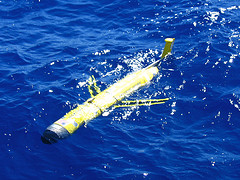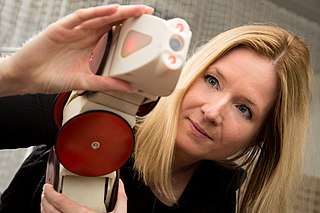Related Research Articles

Kongsberg Gruppen is an international technology group that supplies high-technology systems and solutions to customers in the merchant marine, defence, aerospace, offshore oil and gas industries, and renewable and utilities industries.

A remotely operated underwater vehicle is a tethered underwater mobile device.

An autonomous underwater vehicle (AUV) is a robot that travels underwater without requiring input from an operator. AUVs constitute part of a larger group of undersea systems known as unmanned underwater vehicles, a classification that includes non-autonomous remotely operated underwater vehicles (ROVs) – controlled and powered from the surface by an operator/pilot via an umbilical or using remote control. In military applications an AUV is more often referred to as an unmanned undersea vehicle (UUV). Underwater gliders are a subclass of AUVs.
The AN/BLQ-11 autonomous unmanned undersea vehicle is a torpedo tube-launched and tube-recovered underwater search and survey unmanned undersea vehicle (UUV) capable of performing autonomous minefield reconnaissance as much as 200 kilometers (120 mi) in advance of a host Los Angeles-, Seawolf-, or Virginia-class submarine.

An underwater glider is a type of autonomous underwater vehicle (AUV) that employs variable-buoyancy propulsion instead of traditional propellers or thrusters. It employs variable buoyancy in a similar way to a profiling float, but unlike a float, which can move only up and down, an underwater glider is fitted with hydrofoils that allow it to glide forward while descending through the water. At a certain depth, the glider switches to positive buoyancy to climb back up and forward, and the cycle is then repeated.
Unmanned underwater vehicles (UUV), sometimes known as underwater drones, are any submersible vehicles that are able to operate underwater without a human occupant. These vehicles are robotic, and may be divided into the two categories of remotely operated underwater vehicles (ROUVs), which are remotely controlled by a human operator; and autonomous underwater vehicles (AUVs), which are highly automated and operate independently of direct human input. Sometimes only vehicles in the second category are considered a kind of autonomous robot, but those in the first category are also robots though requiring a remote operator, similar to surgical robots.

Kongsberg Maritime (KM) is a Norwegian technology enterprise within the Kongsberg Gruppen (KOG). Kongsberg Maritime deliver systems for positioning, surveying, navigation, and automation to merchant vessels and offshore installations. Their most well known products exist within dynamic positioning systems, marine automation and surveillance systems, process automation, satellite navigation, and hydroacoustics.
Subsea is fully submerged ocean equipment, operations or applications, especially when some distance offshore, in deep ocean waters, or on the seabed. The term is frequently used in connection with oceanography, marine or ocean engineering, ocean exploration, remotely operated vehicle (ROVs) autonomous underwater vehicles (AUVs), submarine communications or power cables, seafloor mineral mining, oil and gas, and offshore wind power.
The Seaglider is a deep-diving Autonomous Underwater Vehicle (AUV) designed for missions lasting many months and covering thousands of miles. In military applications the Seaglider is more commonly referred to as an Unmanned Underwater Vehicle (UUV).
The Sentry is an autonomous underwater vehicle (AUV) made by the Woods Hole Oceanographic Institution. Sentry is designed to descend to depths of 4,500 metres (14,800 ft) and to carry a range of devices for taking samples, pictures and readings from the deep sea.

Docking and berthing of spacecraft is the joining of two space vehicles. This connection can be temporary, or partially permanent such as for space station modules.
Phoenix International Holdings, Inc. (Phoenix) is an employee owned marine services company that performs complex manned and unmanned underwater operations worldwide. Phoenix was incorporated in 1996 as Phoenix Marine, Inc. and started doing business in 1997. It changed its name in January 2000 to Phoenix International, Inc., and then to Phoenix International Holdings, Inc. in November 2007 when it became an employee owned company.

The Fleet-class unmanned surface vessel, also called the Common Unmanned Surface Vessel (CUSV) and later the Mine Countermeasures Unmanned Surface Vehicle, is an unmanned surface vessel designed for the United States Navy to be deployed from Freedom and Independence-class littoral combat ships and intended to conduct mine and anti-submarine warfare missions. As of 2012 four units of the class have been built; the first was delivered to the U.S. Navy in 2008.

The REMUS series are autonomous underwater vehicles (AUVs) made by the Woods Hole Oceanographic Institution and designed by their Oceanographic Systems Lab (OSL). More recently REMUS vehicles have been manufactured by the spinoff company Hydroid Inc. a wholly owned subsidiary of Kongsberg Maritime. The series are designed to be low cost, they have shared control software and electronic subsystems and can be operated from a laptop computer. They are used by civilians for seafloor mapping, underwater surveying, and search and recovery as well as by several navies for mine countermeasures missions.
The Knifefish is an autonomous unmanned underwater vehicle (UUV) under development by General Dynamics Mission Systems and Bluefin Robotics for the United States Navy. It is a propeller-driven minesweeping robot designed to replace the Navy's trained dolphins and sea lions after the retirement of the 50-year-old Marine Mammal Program in 2017. The Knifefish was first unveiled at a Navy exposition in April 2012, and is intended to operate in concert with the Navy's littoral combat ships (LCS) as part of a specialised counter-mine system. The Navy plans to begin sea trials of the Knifefish in 2015, and to enter it into active service in 2017.

Ships husbandry or ship husbandry is all aspects of maintenance, cleaning, and general upkeep of the hull, rigging, and equipment of a ship. It may also be used to refer to aspects of maintenance which are not specifically covered by the technical departments. The term is used in both naval and merchant shipping, but naval vessel husbandry may also be used for specific reference to naval vessels.
BAE Systems Maritime – Maritime Services is a wholly owned subsidiary company of BAE Systems, specialising in the repair and maintenance of Royal Navy vessels, as well as product development, naval training and through life support for radar, torpedoes and small boats. Along with BAE Systems Maritime – Submarines and BAE Systems Maritime – Naval Ships, it is one of three divisions of BAE Systems Maritime.
Diving support equipment is the equipment used to facilitate a diving operation. It is either not taken into the water during the dive, such as the gas panel and compressor, or is not integral to the actual diving, being there to make the dive easier or safer, such as a surface decompression chamber. Some equipment, like a diving stage, is not easily categorised as diving or support equipment, and may be considered as either.

Kristin Ytterstad Pettersen is a Norwegian engineer whose research involves nonlinear control theory and its application to controlling the motion of both watercraft and snakebots. She is a professor of engineering cybernetics at the Norwegian University of Science and Technology, and the founder of Eelume AS.
The Orca is an autonomous underwater vehicle (AUV) that is under development by Boeing and Huntington Ingalls Industries (HII) for the United States Navy.
References
- ↑ Brokaw, Alex (April 21, 2016). "This terrifying eel-robot will perform maintenance on undersea equipment". The Verge.
- 1 2 3 Carl, David (February 24, 2018). "Kongsberg to test Eelume unmanned subsea residency vehicle". Jane's Information Group.
- ↑ Thomas, Nathalie (April 18, 2017). "North Sea producers turn to robots to cut costs". Financial Times.
Statoil is working with Eelume, a Norwegian underwater robotics company, on developing a snakelike swimming robot that can both inspect and carry out easy repairs on subsea infrastructure such as pipes.
- 1 2 3 4 Addison, Velda (March 29, 2017). "Eelume Aims To Go Deeper With Robotic Subsea Snake". Hart Energy.
- ↑ Liljebäck, Pål; Mills, Ricard. "Eelume: A Flexible and Subsea Resident IMR vehicle". Kongsberg Maritime.
- ↑ Atherton, Kelsey D. (February 17, 2017). "Watch a snake robot wriggle through a Norwegian fjord". Popular Science.
Once outfitted, the robots can settle into their watery home: Eelume AS designed them to stay underwater permanently, in a little docking station on the bottom of the sea. From there, they can swim out to inspect and repair undersea infrastructure, like pipelines or oil rigs, without any concern about the weather above the ocean's surface.
- ↑ Nilsen, Kjersti Lunden (20 December 2019). "Subsea "Snake Robot" Inventor Wins Prestigious Cybernetics Prize". Maritime Executive.